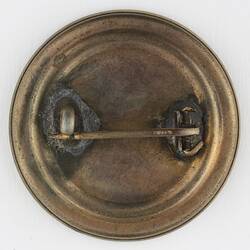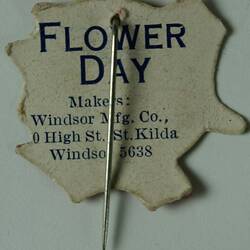Summary
Alternative Name(s): Button
'Children's Flower Day' badge, made to raise funds for World War I.
Flower Day had its origins in the League of Young Gardeners, created in Victoria in 1916 to 'swell the war relief fund, by cultivating garden plots at home'. From this movement sprang several 'Flower Days' which raised £126,354 for war relief. In 1916, the Victorian Education Department instructed teachers to promote gardening initiatives, and announced that there would be a November Flower Day. The main event of the Day was to be a fund-raising flower show from school gardens - 'Let the children feel that the show is to be their show', advised Supervisor of School Gardening, Cyril Isaac. At schools, the day consisted of morning lessons on war-related topics; in the afternoon schools set up street stalls to sell bouquets and button holes. The main show was not held in 1918 due to stringent war economies, but £50,000 was still raised. The event petered out after World War I.
Physical Description
Round metal badge with gold coloured outer border. A white banner with red words on it encircles a bouquet of blue and yellow flowers (possibly boronia and wattle) on a white background. Metal pin is attached to back.
More Information
-
Collecting Areas
-
Acquisition Information
Donation from Mr H. Legge, 14 Feb 1989
-
Place & Date Used
-
Inscriptions
On banner: 'CHILDREN'S / FLOWER DAY / 1918'
-
Classification
-
Category
-
Discipline
-
Type of item
-
overall dimensions
10 mm (Height), 33 mm (Outside Diameter)
-
References
Information on Flower Day from the Australian War Memorial web site - record for REL39124 - Fundraising badge : Children's Flower Day 1919 Peace Year, [Link 1] accessed 27/9/2012; and Rosalie Triolo, 2012. 'Our Schools and the War', pp. 88-90.
-
Keywords
Badges, Charities, World War I Fundraising, World War I, 1914-1918











